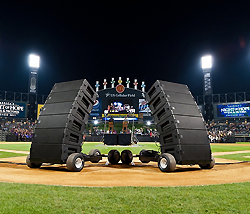
More Capabilities & Control
Once the pro audio industry has become comfortable with the basic practice and implementation of optimization, the capabilities could be readily expanded.
As CPU power continues to improve, optimization time will decrease as performance and precision increases. Ultimately, processing time will become so short that these systems will be able to adapt to changing site conditions in real time.
As an example: utilizing self-monitoring and the performance criteria entered by the user, a loudspeaker array could automatically recalculate processing parameters mid-concert to maintain reasonable performance upon detection of a driver failure or environmental change such as temperature or humidity increase.
Similarly, by monitoring each component with an understanding of its role in the system, advanced limiting functions could ensure that the system maintains coverage and tonality, even if some driver is operating at capacity. Anyone who has had a particular pass-band limit before the rest will understand the impact that this phenomenon can have on the performance of a system.
Because we have made the shift from defining performance at the loudspeaker to defining performance at the audience, the operator should also have the convenience of addressing location-specific issues by the actual audience area instead of the part of the array responsible for covering it.
To account for acoustical inconsistencies throughout the space, the operator could make equalization adjustments in specific parts of the audience, or ‘zones’ in software – but in this case, these are audience zones and not loudspeaker zones. The user need only define what they want to achieve in the actual audience area, and the optimization program (and loudspeaker DSP) determines what is necessary to achieve that.
As we’ve said, the operator should not be concerned with what is electronically or physically required to achieve that additional cut at 2.5 kHz in the upper balcony. At low frequency, where it may be more difficult to isolate specific parts of the venue, it is the duty of the optimization program to alert the user as to the available ‘spatial resolution’, or the effect of what they are doing in one area on the others.
Fast Forward
An ultimate goal for “optimized” systems of any scale should be decreasing or eliminating dependence on mechanical adjustments. This means that arrayed loudspeakers will require no articulation or splay, perhaps with the exception of extreme down-fill (which could be, as they are today, a different design that incorporates some pre-determined curvature).

As noted, though steady progress is being made in this area by way of “steerable” column loudspeakers, it is yet to be fully implemented in large or even medium-scale systems. But if the optimization criteria and process are accepted and well implemented, it is not a big jump for the user and in fact even simplifies the situation as compared to optimized systems with both electronic and mechanical variables.
When loading in for a concert, for example, the instruction to the crew changes from “set the splay angles and cable the arrays as per this spreadsheet” to “hang X boxes there and plug them in.” With a system that self-recognizes quantity, position, role, and relationship to other components, no further details are necessary.
Since everything is handled in software, this technology can also easily be expanded to other configurations, such as distributed systems. In this case, delay times, band-pass filtering, and the directivity of each distributed point could be calculated automatically.
Lest some live sound engineers read these articles and assume that this technology is destined for installed systems only because of time or complexity, think again. With “smart phone” technology, the user will be asked for progressively less raw data, leveraging features such as wireless communication, GPS, on-board cameras, inclinometers and accelerometers to gather all of the information needed about the venue.
And with increasing prevalence of digital consoles capable of running third-party plug-ins and integrating into networks, the operator won’t even need an external computer or processing box to set their system up. What may now appear as somewhat of a science experiment will become common, just as it did for any of the digital devices which are now commonly used: consoles, audio networks, amplifiers, etc.
So as to not make it too easy for the manufacturers, we will discontinue our discussion here. But suffice it to say, this article has only just scratched the surface of what’s to come for this area of our industry!
Adam Shulman is a consultant with SIA Acoustics, a leading acoustical and system design firm with headquarters in New York City.
